Total Word File Recovery Solution to Recover A Word Document
- Recover a Deleted Word document
- Restore an Unsaved Word File
- Retrieve a Word Document After the Computer Crash
- If you've saved a Word document to the wrong location, you can try searching for it on your computer. You can also check the "Recent" section in Word to see if the document has been opened recently. If you're still unable to find the document, you can try looking in the "Downloads" folder or the "Documents" folder, as these are common locations where Word documents are saved.
- Recover an Accidentally Overwritten Word Document
- Recover Temporary Word Files
- Recover a Word Document That Was Saved Over
- Repair Corrupted Word File Online
- Repair a Corrupted Word Document that Won't Open
- Tips for Preventing Word File Loss in the Future

Microsoft Word, also known as MS Word, is a basic computer word processing program used for creating text documents, such as letters and official papers. It offers various advanced features, including the ability to add graphics, spell and grammar checks, auto-formatting, and table of contents. Additionally, it comes with an online collaboration tool that allows multiple users to simultaneously read, write, or make changes to a document saved in OneDrive.
Even with Microsoft Word's built-in "Auto Recovery" and online "Auto-Save" features, documents can still vanish suddenly, leaving users with no clear explanation for the disappearance.
Reasons for disappearing documents:
- ❌ I can help you recover deleted documents. To do that, I'll need to know what kind of document it was (e.
- 📑 You haven't saved the documents before exiting from the page.
- 📤 When working offline and the online "Auto-saved" OneDrive feature is not enabled, files may not be saved and can disappear.
- 🖥️ Sudden software crash or accidental formatting of partitions/disks
- 👽 Any bug or malware attack on your system could cause the sudden and unexpected deletion of your Word document.
Losing a Word document can be frustrating, but instead of panicking, you can take action to recover it quickly. Whether you need to retrieve a lost file for business or personal reasons, this article provides solutions to help you recover your Word document in various situations, saving you time and stress. By following the guidance here, you can regain access to your lost Word files and get back to work without delay.
How to Recover a Deleted Word Document
If you're looking for a reliable tool to quickly recover lost Word files, Deep Data Recovery is a trusted option. This virus-free software is suitable for both beginners and professionals, and can easily recover Word files on both Windows and Mac computers, making it a convenient solution for all data recovery needs.
The tool aims to facilitate Word document recovery in a straightforward manner. To utilize it effectively, it is advisable to stop using the disk where the files were lost, thereby preventing data overwriting issues.
- Advantages:
- Beginner-friendly user interface and built-in navigation
- Recovers files from more than 2000 storage devices
- Recovers files in various data loss scenarios
- Has a file recovery success rate of 99.65%
- Saves time and provides professional assistance
- Applicable users/scenarios:
- To recover RAW drives or a deleted file
- To restore partition after deleted, lost or hidden
- To recover lost files due to virus and malware attacks or hard drive crash, you can use data recovery software such as EaseUS, Recuva, or Disk Drill. These tools can scan your system and restore deleted files, even if they're hidden or corrupted.
- If the storage device is erased unexpectedly
Step-by-step guide:
- Install and launch the Deep Data Recovery software on your computer.
- On the app's main interface, select and scan the drive where you lost your Word document, such as the C drive if the document is in the Documents folder, and then click the Scan icon.
- Please wait for the scanning process to complete, then check the found files. Once you find the document, save it in a safe place.

Recover an Unsaved Word Document Using the AppData
The default autosave location for MS Word is AppData, a hidden directory in your system where unsaved Word files are stored, along with custom settings and other system application data.
- Applicable scenarios:
- When you need to recover an unsaved document in Word on Windows 11/10/8/7.
Step-by-step guide:
- To open the Run command, press the Windows key and the R key on your keyboard together. This will open a small window where you can type in a command or program name to run.
- To open the AppData folder in File Explorer, type "AppData" in the search box and press Enter. This will open the AppData folder.
- Next, navigate to: Local > Microsoft > Office > UnsavedFiles
- Open the file you want to recover from File Explorer and click on it to select it. Then, click on the "Open" button.
- Save the recovered Word document by tapping the "Save As" button to select a location and file name for the saved document.
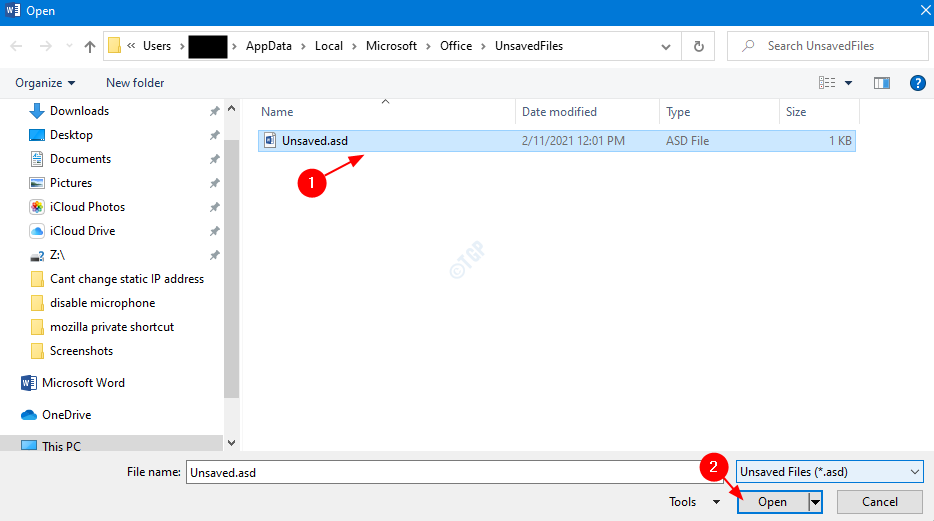
If the above method doesn't work, you can try other methods to restore unsaved Word files, such as using the autosave feature or searching for a temporary file that Word may have created. You can also try using a third-party recovery software to scan your computer for any recoverable files.
Recover a Word Document after a Computer Crash Using the AutoRecovery Feature
Microsoft Word allows auto recovery of lost or deleted files, even in cases of system crashes, giving users a second chance at recovering their important documents. This feature can be especially helpful when a PC crashes due to technical issues, rather than user error.
- Limitations:
- Unfortunately, it's not possible to recover a Word file that has been overwritten or replaced, as the original file's contents are lost forever. Once a file is deleted or replaced, the data is gone, and there's no way to retrieve it.
Step-by-step guide:
- Once your system is back online, reopen MS Word. The unsaved files should auto-recover, and you can click "Show Recovered Files" to access them.
- To recover a Word file that is not automatically recovered, you can try the following steps: Save the file as an older version, check for corrupted files, and use the built-in recovery tool. You can also try using a third-party recovery software to scan the file and recover any lost data.
- Select File > Options > Save
- To access the AutoRecover file location, you need to copy the file path and paste it to File Explorer. This will allow you to locate the AutoRecover files saved by Microsoft Office applications.
- To proceed, open the folder containing your document's name, locate the file with the most recent modified time and date, and copy the .asd file from that folder.
- To reopen a recently unsaved document in MS Word, go to File, then click on Open, and finally select Recover Unsaved Documents from the list at the bottom. This will allow you to access and reopen any recently unsaved files.
- After the file is copied, paste it into the popped-up folder. Then, open the file to recover your Word document.
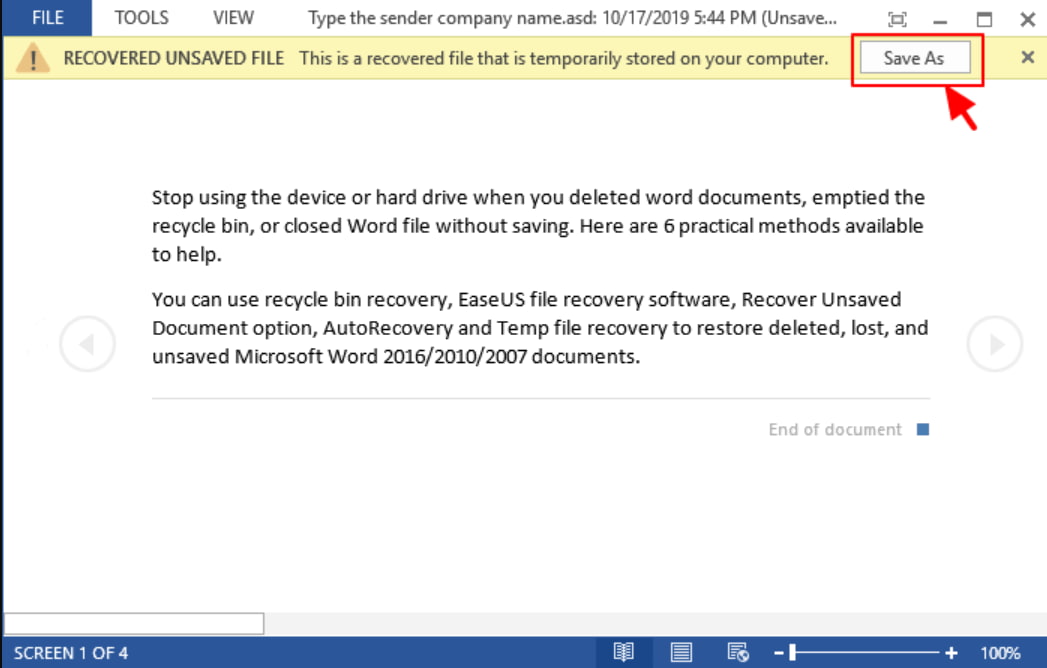
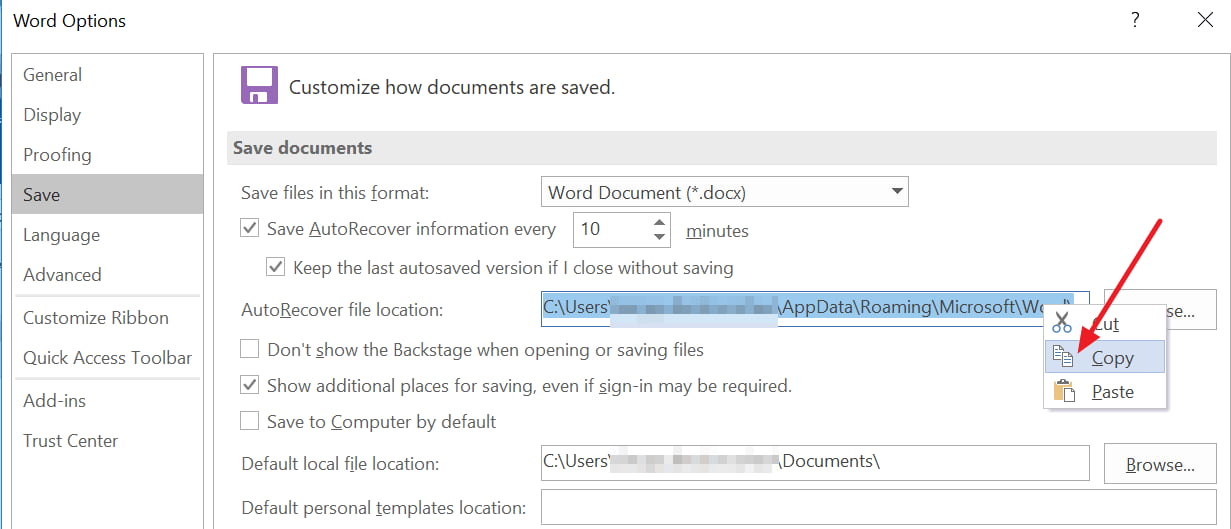
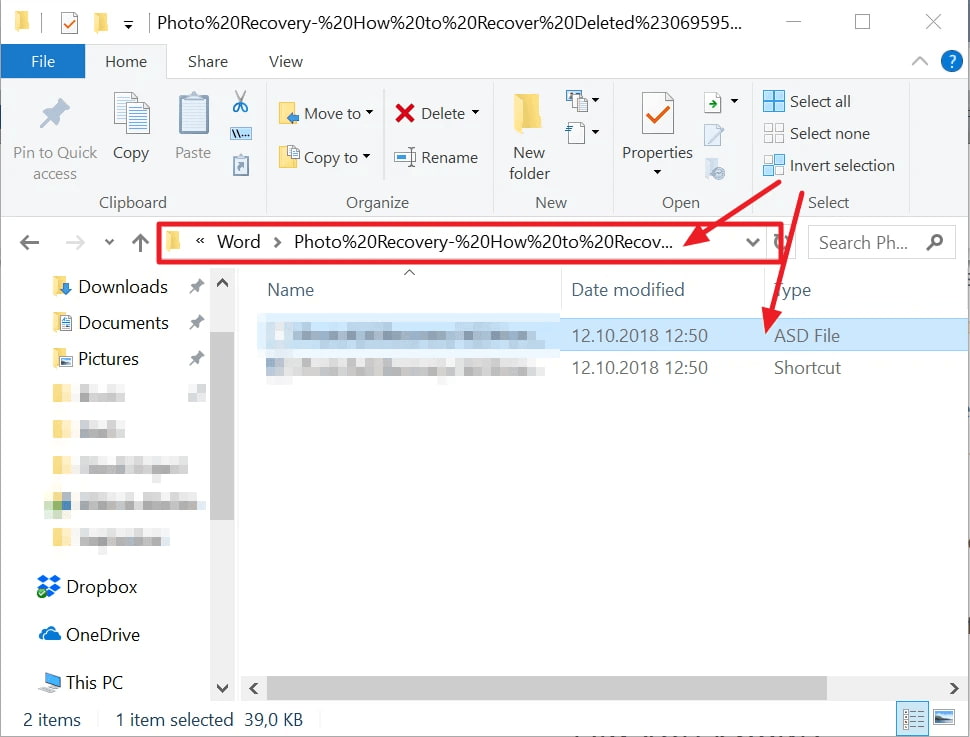
How to Recover a Word Document that was Saved to the Wrong Location?
If you can't find your saved Word file, you can use Windows File Explorer to quickly locate and recover it. This is the best, quickest, and easiest method to track the location of your saved Word document and retrieve it in no time.
- Limitations:
- It doesn't work to recover a deleted Word file.
- Applicable Scenarios/ Users:
- If you can't recall the location of the Word document, try searching your computer or device for the file. You can also check your recent documents or open the Word application and see if it's listed in the 'Recent' or 'Open' tabs.
- When data is stored on a path that is not used frequently, it can lead to slower data retrieval times and increased storage costs, as the data is not being accessed and utilized, resulting in wasted resources. This can be due to various factors such as data redundancy, inefficient data management, or simply storing data in a location that is not easily accessible.
- Search any file and document within seconds
Step-by-step guide:
- Run the Windows File Explorer on your system.
- To search for a file, open the search box, which is usually located in the top right corner of the window, and type the file name or relevant keywords. This will bring up a list of matching files, allowing you to quickly locate the desired document.
- Wait until the search process completes.
- Once you've located the file, click on it to view its contents and save it to your desired location.
Recover an Accidentally Overwritten Word Document Using the Previous Version
To recover a Word document accidentally overwritten, you can quickly trace its previous versions by enabling the backup option and regularly backing up your files. This method works effectively only if you have done so for all arrangements.
- Limitations:
- To enable the File History feature, go to Settings > Update & Security > Backup, and select the drive you want to back up. Then, select the files and folders you want to include in the backup.
- Applicable scenarios/users:
- To revert your process of Windows' Word and Excel documents
- To recover the original and earlier versions of documents that have been accidentally modified, deleted, or damaged, you can use software or cloud services that offer version control and backup features. This allows you to revert to a previous state of the document, effectively restoring it to its original or earlier version.
Step-by-step guide:
- Tap Start > double click on Computer.
- Double-To recover your overwritten Word file, click on the drive where the file was located and select the file location.
- Next, right-To restore a previous version of a Word document, click on the Word document and select Restore previous versions. This will display all available versions and their locations.
- Select the version you need to restore and click the Restore button.
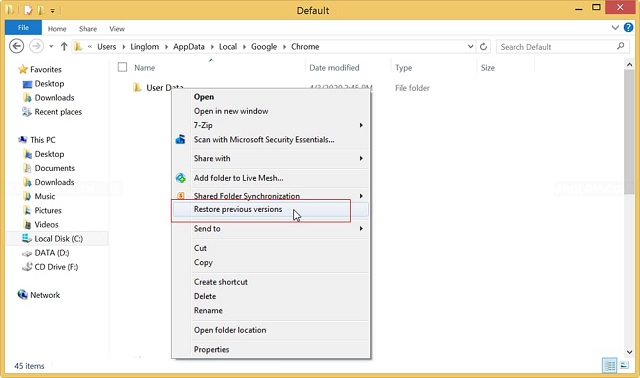
If you've lost your Word file due to an overwrite, don't panic. You can try using the 'Undo' feature if you've acted quickly enough.
Repair a Corrupted Word Document that Won't Open Using the Trust Center Settings
You can use the Trust Center Settings in MS Word to customize privacy and security settings, which can help repair and recover corrupt Word documents that won't open. Additionally, you can share your Word file with others while restricting confidential information, and disabling protected view settings can also help resolve issues with corrupt files.
- Cons:
- You must enable the settings beforehand to make them work.
- Applicable scenarios/users:
- Customization of privacy and security settings
- Open corrupt Word files (DOC and DOCX)
Step-by-step guide:
- Open the MS Word app on your PC.
- Open the File menu and click Options.
- Select the Trust Center and click on Trust Center Settings.
- To disable Protected View, tap the Protected View tab, unmark all the available boxes, and select OK.
- To close your Word application and open the file you need, simply click the "X" button in the top-right corner of the Word window to close the application, and then navigate to the file location on your computer or network where the file you need is saved. Once you've located the file, double-click on it to open it in Word.
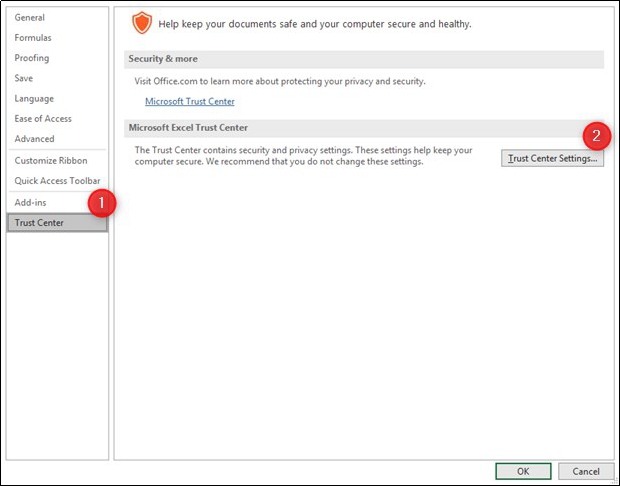
Tips for Preventing Word File Loss in the Future
To avoid losing your Word document data, it's best to take preventive measures beforehand, such as regularly saving your work, using cloud storage, and having a backup plan in place. This way, you can avoid the hassle of trying to recover a lost document later.
- 🖥️ Keep your system clean and dust-proof.
- 💽 Save your Word file on a secondary drive, not the primary drive or operating system, to prevent potential data loss.
- ⛔ To avoid accidentally deleting your Word document while editing, use the F12 key to save a copy of the file with a different name before making changes. This way, you can recover your original file if needed.
- 📧 Be cautious with emails and attachments from unknown sources, and keep your antivirus software up-to-date to protect against potential threats.
- ⛱️ To ensure the safety of your important Word documents, it's a good idea to create regular backups and store them in a fireproof vault. This way, you can have multiple copies of your files at different locations, and consider encrypting them for added security.
- 🎏 You can also use Cloud storage to save a backup of your Word files for a double layer of protection.
- 🗃️ Be cautious when receiving email attachments, as they can potentially overwrite your original documents if saved in the same location. To avoid this, save attachments in a unique and designated place. This simple habit can help prevent accidental overwrites and ensure your important documents remain intact.
- 📰 To ensure you have access to your Word files in case you lose them, it's a good idea to keep hard copies of your documents. This way, you can still refer to them even if your digital copies are lost or become inaccessible.
Conclusion
Technology has not advanced enough to prevent losses, so it's essential to take proactive measures to protect your data. This includes enabling built-in features to have a solid backup, ensuring your data is safe even in case of accidental loss.
If you fail to retrieve your valuable data and need to recover a Word document, you can rely on the Deep Data Recovery software, which is a one-stop solution for all your Word file recovery needs.
Frequently Answered Questions
-
To retrieve an unsaved Word document, navigate to AppData, which is usually located in the user's profile folder, and look for the Word Temporary Files folder. You can then search for the document's file name, which should be in the format of "document.dotx" or "document.
-
Using the Trust Center Settings in Microsoft Word is the safest and most cost-effective way to repair and recover corrupt Docx files.
-
Saving or accessing your Word files on a fragmented disk can cause them to be corrupt, as well as other issues such as round-tripping, improper download, and header corruption.
-
Deep Data Recovery software can easily recover corrupted Word files by using its advanced search process to repair them during the scan, making the recovery process less challenging.
-
Files can become corrupted due to various reasons, including power failures, bad sectors on the hard drive, user errors, phishing, program crashes or freezes, and improper system shutdowns. Additionally, viruses and malware can also cause file corruption.
-
Formatting the drive will erase all data, including backup files, but Qiling Word document recovery software can still help recover lost data.
- Download and install Deep Data Recovery
- After launching the program, click "go to setting" to deselect other file types.
- Select the formatted drive to scan
- Preview erased word files and re-save them to the drive
Related Articles
- M3 RAW Drive Recovery Crack Alternative with License Code/Key
Stop using M3 data Recovery crack for data recovery. Download M3 RAW Drive Recovery crack alternative software with license code to effectively recover your lost documents, videos, images, audio files, and other types of files from RAW SD card, hard drive, USB, etc., with ease. - How to Fix Microsoft Office Cannot Open This File Because Some Parts Are Missing or Invalid
Is your screen showing the error message - Microsoft Office cannot open this file because some parts are missing or invalid when you try to open an old file? Do not worry because we have got the right solutions for you! If you have corrupted Office files, turn to Qiling file repair software and you can get the corrupted Word, Excel, PPT, and PDF files back with simple steps. Read on to solve your problem. - How to Mount ISO File in Windows 10/11
You can access and mount the contents of an ISO image in several ways. In this guide, you'll learn to mount ISO images on Windows 10. A reliable file recovery tool is provided to help you restore ISO files if necessary. - Fix No Writable WD Smartware Partition Found and Recover Data
WD My Passport not recognized or become inaccessible in Windows or Mac due to No writable WD SmartWare partition found error? Here, useful instructions are created to help you fix the issue on Western digital hard drive and recover lost partition data.